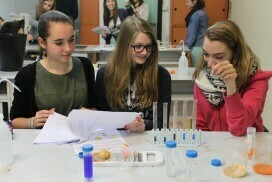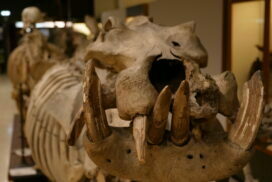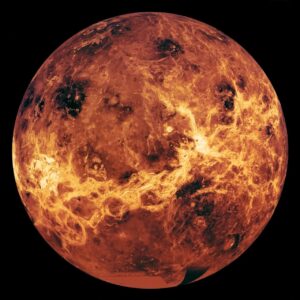Venus: Earth’s Toxic Alter Ego
Author: Davide Dionese
Type: Telluric planet
Orbital period: 225 Earth days
Day length: 243 Earth days (longer than its year!)
Diameter: 12,104 km (95% of Earth’s size)
Mass: 81.5% of Earth’s mass
Atmosphere: 96% carbon dioxide, with thick clouds of sulfuric acid
Surface temperature: ~464°C, the hottest planet in the Solar System
Moons: None
Distance from Sun: ~108 million km (~0.72% of the Earth-Sun distance)
Surface pressure: 92 times that of Earth (equivalent to being 900 meters underwater)
Venus, the second planet from the Sun, is often called Earth’s sister or “evil twin.” Despite its similar size and composition, beneath its golden clouds lies a scorching, inhospitable world.
A Brief History
Venus has captivated humans for millennia. Named after the Roman goddess of love and beauty, it is one of the brightest objects in the sky. Ancient civilizations, including the Babylonians and Mayans, tracked its movement, often associating it with divine forces. Venus’ phases were first observed by Galileo Galilei in 1610, providing crucial evidence for the heliocentric model of the Solar System.
The first successful spacecraft to visit Venus was NASA’s Mariner 2 in 1962, which confirmed its extreme surface temperatures. The Soviet Venera program made significant advances, including the first landing (Venera 7, 1970) and the first images from its surface (Venera 9, 1975).
A Fiery World
Despite its similarities to Earth, Venus is radically different. Its thick atmosphere traps heat so effectively that it is the hottest planet in the Solar System, even hotter than Mercury. The surface is covered with vast volcanic plains, towering mountains, and deep rift valleys. Over 85,000 volcanoes have been mapped, and scientists believe Venus is still geologically active, with some volcanoes potentially erupting today. On top of that, the planet is shrouded in toxic clouds of sulfuric acid, making it even more inhospitable.
Interesting Facts
- A Day Longer Than a Year: Venus rotates so slowly on its axis that a single day (243 Earth days) is longer than a year (225 Earth days). Even stranger, it spins backward, causing the Sun to rise in the West and set in the East!
- Earth’s Evil Twin?: Some scientists believe Venus may have had oceans billions of years ago. However, a runaway greenhouse effect likely boiled them away, turning the planet into the inferno we see today.
- A Crushing Atmosphere: The air pressure on Venus is so intense that most landers survive only a few hours before being crushed. The Venera 13 probe lasted an impressive 127 minutes, while Venera 7 only survived 23 minutes.
- The “Morning Star” and “Evening Star”: Venus is the third brightest natural object in the sky, and due to its proximity to the Sun, it can only be observed close to dawn and dusk. Ancient cultures thought it was two separate objects—one appearing at sunrise and another at sunset.
- Super-Rotating Atmosphere: While Venus spins slowly, its upper atmosphere moves at hurricane speeds of up to 360 km/h (224 mph), completing a full rotation around the planet in just four days.
- The quasi-satellite Zoozve: While Venus has no natural moons, it shares its solar orbit with Zoozve, a quasi-satellite that remains in close proximity to the planet. Discovered in 2002 by Brian Skiff at Lowell Observatory, it was the first known quasi-satellite of a major planet. The name « Zoozve » originated from a misreading of its provisional designation « 2002 VE68 » on a children’s solar system poster, leading to its official naming in February 2024.
Future Exploration
Venus is drawing renewed interest from space agencies. NASA’s VERITAS and DAVINCI+ missions, along with Europe’s EnVision, aim to study its geology, atmosphere, and potential past habitability. Understanding Venus could provide insights into Earth’s future and the factors that shape planetary climates.
Despite its beauty, Venus is a harsh and unforgiving world. However, studying its past and present could teach us vital lessons about our own planet and the possibilities of life beyond Earth.















